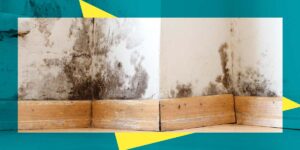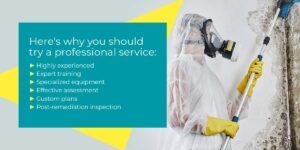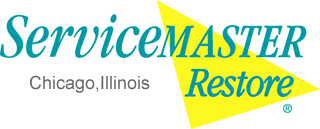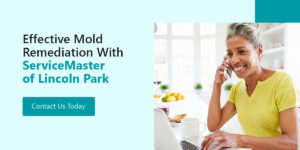
Mold is a persistent problem that plagues many homes and businesses. It poses potential health risks and structural damage if untreated. Bleach is often proposed as a do-it-yourself (DIY) solution for mold removal. However, it’s essential to recognize its limitations. Mold issues can be far more complex than they appear, extending beyond what you can see. Understanding the complexities and risks of bleach and mold removal can help you make an informed decision that prioritizes your health and the long-term well-being of your space.
What Is Mold?
Mold is a fungus that thrives in damp and humid environments. It reproduces through tiny, invisible spores, making it difficult to detect until it’s a significant issue. Mold can grow on many different surfaces, from drywall and wood to fabrics and insulation. Its ability to flourish in hidden, inaccessible spaces — such as behind walls or in HVAC systems — adds to the complexity of the problem.
Mold comes in many colors and can cause harm some people’s health. People with asthma, weakened immune systems or mold allergies are more susceptible to mold’s negative health effects. These effects are the main reason attempting to remove mold without the proper knowledge and protective measures can pose serious health risks. Mold spores can become airborne during removal and lead to respiratory problems, allergic reactions and other health issues. DIY methods like bleach often lack the proper containment and filtration systems that professionals use to minimize these risks.
Bleach and Mold Removal
Many home and business owners dealing with mold attempt to use DIY methods to get rid of their mold issues. However, using bleach to remove mold can be dangerous. If you’re dealing with mold, you should fully understand its growth and how it interacts with bleach before trying to clean it up yourself.
Does Bleach Make Mold Worse?
Bleach doesn’t make mold worse but also doesn’t help you eliminate your mold problem. Bleach making mold worse is a common misconception — while bleach can kill mold on non-porous surfaces, reducing its growth temporarily, you won’t get rid of it if you haven’t solved the root moisture problem. Properly diluted bleach can be helpful, but it’s not part of a comprehensive mold-removal strategy and can cause serious health problems.
Will Clorox Bleach Kill Mold?
Clorox does kill the initial mold it touches on non-porous surfaces. However, it’s not recommended for mold removal processes. Clorox bleach won’t kill mold on porous surfaces, background spores or mold created by still-present moisture. Additionally, bleach emits harmful fumes and doesn’t prevent mold spores from becoming airborne during cleaning, potentially exacerbating respiratory issues. While professionals may selectively use bleach in specific instances, it is not advised for anyone to use bleach routinely during mold remediation.
Bleach does kill some molds in your space, but it’s also likely to damage your surfaces at the same time. Bleach is highly corrosive — it can quickly eat through carpet, fabric, wood and more, permanently damaging these objects. An improperly diluted solution can burn your skin, lungs and surfaces faster than you might think. Mixing bleach with other cleaning products or ammonia can also create dangerous gases. Using professional services instead of DIY-ing with bleach will help protect your space and belongings.
Why Choose Professional Mold Remediation?
Bleach might seem like the most convenient option for mold removal, but you risk hurting yourself and your belongings. Using bleach does not stop the moisture problem that initially caused the mold, so you’ll have to deal with mold repeatedly. Trusting a professional mold removal service can help keep you safe while effectively removing the mold. Instead of choosing bleach, here’s why you should try a professional service:

- Highly experienced: Mold infestations vary wildly in type, extent and location. Mold removal professionals bring years of experience dealing with diverse mold issues. Their expertise allows them to tailor remediation plans to your specific needs and handle any challenges that pop up along the way. These experts have encountered and successfully resolved similar challenges, whether it’s a small, isolated growth or a widespread infestation.
- Expert training: Professional mold removal services employ trained and certified experts who have undergone rigorous training. These professionals understand the science behind mold growth, its species and the exposure to health risks. They’re well-versed in industry safety practices and protocols, ensuring effective and safe mold removal.
- Specialized equipment: Mold removal professionals have access to specialized tools and equipment essential for thorough mold remediation. These tools include high-efficiency particulate air (HEPA) filtration systems, moisture meters and thermal imaging cameras. This technology allows them to detect hidden mold in your walls and ceilings. HEPA filtration captures airborne mold spores during removal, preventing their spread to other areas. Advanced removal methods allow them to eradicate mold instead of temporarily removing it.
- Effective assessment: One of the primary benefits of professional mold removal is the comprehensive mold assessments. Using specialized equipment, professionals uncover hidden mold and identify species. They work to find the difficult mold you can’t remove yourself. Thorough assessments help professionals identify all your mold issues instead of just removing visible mold. This knowledge is the foundation for developing precise and effective remediation strategies for each mold issue.
- Custom plans: These experts create customized remediation plans that account for mold type, contamination levels and potential health hazards. Their strategies encompass containment measures to prevent cross-contamination, specialized cleaning techniques to eradicate mold at its source and recommendations for addressing underlying causes.
- Post-remediation inspection: Reputable mold removal services go the extra mile by carefully inspecting for mold after remediation. Mold can return if even a small amount remains, so professionals examine the area to double-check that the mold problem will not resurface. A thorough inspection helps ensure safe indoor air quality and deliver long-term solutions for a mold-free living environment. This commitment to results ensures your peace of mind and the health of your home and family.
Effective Mold Remediation With ServiceMaster of Lincoln Park
Don’t hesitate to take action if you’re dealing with a mold issue in your home or business. ServiceMaster of Lincoln Park is your trusted partner in effective mold remediation, whatever your mold issue. Our certified experts will assess, customize and execute a thorough mold removal plan, ensuring your space is safe and healthy. Your well-being is our top priority — we’re here to provide you with a mold-free living environment you can trust.
Say goodbye to mold issues — contact us today for professional results. Act now and experience the difference mold remediation makes with ServiceMaster of Lincoln Park.


